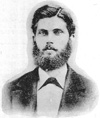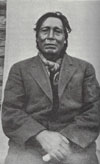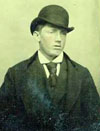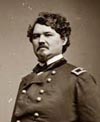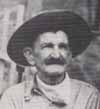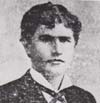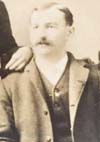Note: New information is in bold.
Michael John Walsh was born in Ireland on June 6, 1852. He was a Private in Company H who was not present at the Battle of the Little Bighorn because he was under arrest in Louisiana following his desertion.
William M. Harris, a Medal of Honor recipient, died on June 6, 1885, in Berea, Madison County, Kentucky, during a gunfight. He was a Private in Company D who participated in the hilltop fight. He was buried in the Ballard/Jarman Cemetery in Bobtown, Madison County, Kentucky, and was later moved to the Camp Nelson National Cemetery in Nicholasville, Kentucky.
John James Carey was born on June 7, 1853, in Troy, Rensselaer County, New York. He was a Private in Company B who was with the pack train and participated in the hilltop fight during the battle.
John Jordan Crittenden III (left) was born in Russellville, Logan County, Kentucky, on June 7, 1854. He was a Second Lieutenant with Company L who was killed with Custer’s Column.
Willis B. Wright was born on June 7, 1859, in Oskaloosa, Iowa. He was a Private with Company C who was killed with Custer’s Column.
Strikes the Bear (left) died in Ree, North Dakota, on June 7, 1929, and was buried as Red Star in the Indian Scout Cemetery in McLean County, North Dakota. His gravestone states his death date as May 12, 1929, but the June date appears to be the accepted date among researchers. He was an Arikara Scout who was with Reno’s Column when it crossed the river.
Bear Comes Out (Matokianapa), who was also known as Comes the Bear and Old Caddoo, died in a drunken brawl, according to Fred Girard, on June 8, 1878, at Fort Abraham Lincoln, Dakota Territory, and was buried in the Indian Scout Cemetery in McLean County, North Dakota. He was a Scout with Reno’s Column but did not cross the river.
Michael Crowe died at Fort Yates in the Dakota Territory on June 8, 1883, and was buried in Keokuk National Cemetery in Keokuk, Iowa. He was a Private in Company B who was with the pack train and in the hilltop fight.
James W. Butler died in Philadelphia, Pennsylvania, on June 8, 1924, and was buried in the National Cemetery there. He was a Private in Company F who was not present due to detached service. He was most likely in the hospital at Fort Abraham Lincoln, but he later claimed to have been guarding the wagon train at the Powder River camp.
Michael Christopher Caddle (left)was born on June 9, 1844, in New York City. He was a Sergeant in Company I who was not present at the battle due to detached service at Powder River, Montana.
Joseph Bates, who was also known as John or Joseph Murphy, was born in Providence, Rhode Island, on June 10, 1838. He was a Private with Company M who participated in the valley and hilltop fights during the battle.
Elmer Babcock (left) was born on June 10, 1856, in Pharsalia, Chenango County, New York. He was a Private in Company L who was killed with Custer’s Column.
Samuel Davis Sturgis (right) was born in Shippensburg, Pennsylvania, on June 11, 1822. Colonel Sturgis was an 1846 graduate of the United States Military Academy at West Point who was Commanding the 7th Regiment of Cavalry at the time of the battle but was on detached service in St. Louis, Missouri. Unfortunately, his son, Second Lieutenant James Garland Sturgis, was with Company E during the battle and was killed.
Edward D. Pigford (left) was born on June 11, 1856, in West Elizabeth, Pennsylvania. He was a Private in Company M who was wounded during the valley and hilltop fights.
William Heyn (right) died in Washington, D.C., on June 11, 1910, and was buried in the Soldiers’ Home National Cemetery there. He was a First Sergeant in Company A who was wounded in his left knee during the valley and hilltop fights.
Peter Eixenberger (left) was born on June 12, 1860, in Munich, Germany. He was a Private with the Band, so he was at Powder River, Montana, when the battle took place.
Peter Gannon died at Fort Assinniboine, Montana Territory, on June 12, 1886. He was first buried in a cemetery there and later reinterred in the Custer National Cemetery on the Crow Agency, Montana. He was a Sergeant in Company B who was not present at the battle due to detached service at the Powder River camp.
Michael Murphy died on June 12, 1904, at the Soldiers’ Home in Washington, D.C., and was buried in the National Cemetery there. He was a Private in Company K who participated in the hilltop fight.

